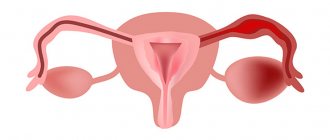Heavy periods in the first 2-3 days of the cycle are usually considered normal. Studies have shown that the average amount of menstrual flow is about 30-40 ml, or about 4-8 teaspoons of blood.
But if you lose more than 90 ml of blood during menstruation, then we can already talk about menorrhagia - a condition characterized by prolonged blood loss (over 7 days), fatigue, dizziness, and sometimes fainting.
What is the difference between abnormally heavy bleeding and heavy periods? What symptoms should a woman pay attention to and when should she not delay visiting a doctor? Let's talk about this serious topic.
Why count a cycle
In addition to the opportunity to stock up on personal hygiene products in time before the next period arrives and prevent an unpleasant situation, the need to be able to count the menstrual cycle allows you to:
- independently monitor your own health and promptly pay attention to the first symptoms of disorders in the reproductive system;
- increase the likelihood of pregnancy by correctly calculating the date of ovulation (the release of a mature egg from the ovary);
- avoid unpleasant surprises, which means correctly planning a doctor’s examination, a long-awaited vacation, or any other important celebration or meeting;
- It is not uncommon for a woman’s cycle to be studied in order to determine the days when sex is considered the safest, although the calendar method itself is not considered reliable, since there is no guarantee that ovulation will not occur earlier or, conversely, will not be delayed for some reason.
Timely detected irregularities in the length of days between menstruation make it possible to diagnose diseases in the early stages, as well as prevent their complications. This is especially true for inflammatory processes, infectious diseases and the appearance of tumors in the genital area.
Tip 4: How to determine how many days a pregnancy lasts without a test
You may be interested in: How to cleanse the maxillary sinuses at home: folk methods, effective recipes
Everything important in life happens suddenly. So pregnancy, no matter how much you prepare for the possibility of its occurrence, is almost always a surprise. Some women want to know exactly how many days a much-desired pregnancy lasts before visiting a gynecologist, others want to stop it as early as possible with the least loss to their health.
Cycle phases and their duration
The main task performed by the menstrual cycle is to prepare the female body for a possible pregnancy, which occurs with a certain cyclicity. The normal cycle length is 21 to 35 days. The beginning of the cycle is the first day of the appearance of characteristic discharge (bleeding). In medical practice, menstruation is also called regula.
The entire cycle consists of two main phases, which are separated by ovulation: follicular and luteal.
In the first case, we are talking about the process of development of the follicle and the maturation of the egg, which, after leaving it, can be fertilized (pregnancy). In the second case, it is customary to talk about the phase of the corpus luteum, which appears at the site of the released egg.
- The first phase (follicular) begins from the moment the first bleeding associated with menstruation appears and lasts until ovulation. In most cases, it takes up about half of the entire cycle and has a basal temperature of 37 degrees, which decreases sharply upon the onset of ovulation itself (this way you can clarify the moment of release of a mature egg and the best opportunity to get pregnant).
- As for the luteal phase, it begins immediately after ovulation and lasts as long as the corpus luteum is present, about two weeks. During this period, the female body must maintain the necessary balance between the amount of estrogens and progesterones produced by the corpus luteum. Basal temperature mostly stays at 37 degrees and drops sharply just before the start of the next menstruation.
The possibility of pregnancy especially depends on the moment of ovulation, since fertilization of a mature egg is possible 3 to 4 days before its onset or in the first 2 days after it.
World Rural Women's Day in Russia
In Russia, more than 21 million women live and work in rural areas. But life in the Russian village is not easy: poverty, low level of mechanization and automation in production, lack of specialists, lack of access to quality medicine and services, etc. That is why one of the main tasks of the Women's Union of Russia is to improve the standard of living in rural areas and create the most favorable conditions for the desire to work in rural areas for the benefit of the state.
In many countries around the world, October 15 is celebrated under the motto of social assistance to rural workers. In Russia, Rural Women's Day is celebrated in different ways:
— every year, various organizations hold mass events where the problems of rural women are addressed; — round tables are held with various slogans (for the availability of loans, for the development of information and communication technologies, etc.); — citywide fairs are held, where village residents bring and sell their products; — exhibitions with agricultural products are organized.
All events are held in an informal atmosphere and are accompanied by performances by artistic groups with a characteristic rural flavor.
World Rural Women's Day reminds society of the invaluable contributions of women. If you know a hard worker, don’t forget to congratulate her. Video on the topic
Possible causes of violations
Irregularities in the menstrual cycle, namely its duration, may be normal or indicate more serious pathologies. Consultation with a gynecologist is especially necessary if disturbances are observed for 2–3 cycles in a row. The true cause of delayed or, conversely, premature menstruation can only be determined by a specialist. In this case, the patient’s complaints, observations, examination results and immediate tests after the examination must be taken into account.
In addition to the untimely onset of bleeding, a cycle disorder is considered to be an altered duration of the discharge itself: less than three days or more than a week. The reason for visiting a doctor is also the absence of ovulation and an uncharacteristic change in the abundance of discharge: less than 40 ml or more than 80 ml for the entire period of menstruation.
- Among the most common causes of irregular periods, it is worth highlighting:
- Gynecological and endocrine diseases.
- Disturbances in hormonal balance in the body.
- Changes in the functioning of the reproductive system during pregnancy or lactation (breastfeeding), as well as after an abortion.
- Disturbances in the production of hormones due to stress, taking medications, sudden weight gain or weight loss.
Why does the cycle lengthen?
An increased period of time between the onset of menstruation may be due to inadequate development of follicles and an immediate delay in ovulation itself. In such cases, there is an absence of the corpus luteum and insufficient production of progesterone. The advantage of estrogen in the body determines the further growth of the functional layer of the uterine mucosa until it begins to break down mechanically and provoke bleeding. Thus, there is a delay in the onset of menstruation.
A more dangerous reason for the absence of timely periods may be the excessively prolonged presence of the corpus luteum, provided that pregnancy has not occurred. The anomaly itself can be determined only after a thorough ultrasound examination of the pelvic organs. On the other hand, it is not uncommon to encounter situations where pregnancy has occurred, but the corpus luteum, which should provide nutrition to the embryo for its further development, is not observed. In such cases, it is customary to talk about the threat of miscarriage. In this case, hormonal treatment is prescribed in order to maintain the pregnancy itself.
Reasons for shortening
A shortening of the period between menstruation may be caused by earlier development of the follicle and the release of a mature egg (ovulation), as well as earlier death of the corpus luteum at the site of the egg itself.
Among the external reasons for the onset of menstruation too early, it is worth highlighting serious diseases of the body, the occurrence of various stressful and extreme situations in which the normal course of pregnancy and the birth of a healthy child is impossible.
Why is it dangerous?
Frequent menstruation should be a reason to visit a gynecologist urgently. This is especially true for situations where menstruation has begun for the third time in a month. If contraceptive methods such as the intrauterine device and pills were not used, there was no stress, childbirth, abortion or climate change, then there is bleeding from the uterus for one of the reasons:
- due to miscarriage;
- ectopic pregnancy;
- neoplasms;
- inflammatory diseases.
Additional symptoms that indicate the need to immediately consult a doctor if you have periods twice a month are:
- a large amount of blood released, clots in it;
- pain of various types in the pelvic area;
- purulent discharge with an odor between periods.
In addition to the fact that repeated periods indicate the presence of pathologies, they are dangerous for all body systems due to significant blood loss.
How to count a cycle
It is a mistake to think that the formula for calculating the duration of the menstrual cycle is too simple and it is enough to count the number of days between the menstruation themselves. Any result output this way will be incorrect. The cycle length is calculated from the first day of the onset of menstruation and includes the last day before the onset of the next characteristic discharge. The whole process is recorded over three months, so you can’t do without a pencil and a calendar. It is necessary to note not only the first day of menstruation, but also all subsequent days when discharge was observed.
Only after the end of the third cycle can you begin to count its duration and be able to determine the first day of the next onset of menstruation:
If in each new month the critical days begin on the same date, then the duration of the menstrual cycle is 30 - 31 days.
The only shift in dates may be observed in March, since February is the shortest month and menstruation may begin a few days later.
In other cases, for example, when the cycle of the onset of menstruation takes 34 days, the date should be calculated taking into account the number of calendar days, since it will move forward several days. In this case, there is no need to predict the onset of menstruation more than 1 - 2 months, since disturbances can be associated with climate change and various stressful situations. If your period is delayed for more than seven days, there is a possibility of pregnancy.
Calculation examples
In order not to get confused about the correctness of individual calculations, it is worth studying how the first day of the menstrual cycle is recalculated each subsequent time based on the following examples:
- If the patient’s previous menstruation began on March 6, and the current one on April 3, then the total duration of the cycle consists of two parts: 26 days in March (from the 6th to the 31st) and 2 days in April. The result is 28 days.
- You can often get confused if the start date of menstruation falls in the middle of the month, for example, September 14. In this case, the beginning of the next discharges dates back to October 13. The calculation is carried out as follows: in September the cycle lasted from the 14th to the 30th and was equal to 17 days, and in October - from the 1st to the 12th - 12 days. Together we get 29 days of one menstrual cycle. The start of the next period should be expected on November 11th.
Single irregularities in the menstrual cycle, which can be explained by stress or strong feelings, should not be particularly frightening or alarming, but if a delay or, conversely, earlier onset of menstruation is observed for three cycles in a row, consultation with a doctor is mandatory. A violation is a pathology if the cycle lasts less than 21 days or exceeds 35 days. It is also important to take into account the number of days on which menstruation occurs. Bleeding for less than three days and more than a week is considered pathology.
Instructions
Look through the horoscope for the current week contained in one of the magazines. Almost every publication, from regular television programs to specialized print media, contains a brief forecast of the events awaiting you and an indication of favorable days.
Buy a monthly publication if you want a more general forecast describing the course of events for the coming month. There you will also find an indication of which days of the month you should hope for success. Please note that some magazines and newspapers even contain quite specific descriptions of the areas in which you can expect good luck: health, family, work or love relationships.
You may be interested in: Is it possible to drink milk at a fever: the opinion of scientists, traditional medicine recipes
Purchase special calendars on astrological topics. In addition to the information described above, they also contain a lot of other information related to recommendations for behavior, and also include a kind of forecasting of the results of your activities in a particular case. For example, you can read what awaits you if you cooperate with a particular zodiac sign or what results will come from shopping on a certain day of the month.
Determine the auspicious day yourself using the instructions of a knowledgeable specialist. You can find it on a site that has earned your trust, or by stopping by a bookstore and rummaging through the shelves among the volumes devoted to astrology. You won't need any complex calculations. Learn the basic rule: the coincidence of the position of the Moon with the sign of your element foreshadows a successful day. Find out the position of the Moon for each current day on specialized websites.
Use another general rule: a favorable day also awaits you if the Moon is in a sign of a related element. For Earth this element is Water, for Fire it is Air.
Video on the topic
Emergency help
If you need to get rid of pain very quickly, then people resort to pills. Very often, patients use antispasmodics and anti-inflammatory drugs. If NSAIDs really help reduce the production of prostaglandins and dull pain, then antispasmodics are completely useless. Unfortunately, very often pain during menstruation cannot be dealt with without pills. Doctors recommend using Ibuprofen, Ketoprofen and Indomethacin. In the absence of contraindications (diseases of the gastrointestinal tract), they can be used throughout the entire period of menstruation.
Other painkillers, as a rule, do not affect the cause of pain, so they are practically useless. Before choosing tablets, it is advisable to consult a doctor. If pain during menstruation continues without interruption, then a visit to a specialist should not be postponed.
Headache
There is a category of people who are predisposed to a migraine attack. It usually occurs just before the start of menstruation and accompanies the entire cycle. A slight weakening of symptoms appears only on the third day after the start of menstruation. As a preventive measure, doctors advise taking tricyclic antidepressants. To relieve pain, use the usual migraine medications. Women prone to this disease are highly discouraged from drinking champagne, beer or cider. Among the foods that provoke pain are cheese, fish and nuts.
During their monthly cycle, they are advised to take sedatives. These can be not only medications, but also herbal decoctions. Women should adhere to a sleep schedule. It's not just about lack of sleep. Sleeping too long in the morning also has an adverse effect on your well-being. Very often, patients who have migraine attacks are sensitive to weather changes, are mentally unstable, nervous and irritable over trifles.
This disease is very often inherited from mother to daughter. To relieve an attack, it is recommended to use triptans, anti-inflammatory drugs and painkillers, as well as ergot extract.
Physical exercise
Swimming is a great way to get rid of discomfort during menstruation. This is one of the most comfortable sports that relaxes and tones the muscles well. You can swim throughout your period, provided that hygiene standards are observed. A woman should use tampons both during and after swimming. Immediately after the water procedure, the used tampon is replaced with a new one.
Physical exercise has a very beneficial effect on health. They can be performed throughout the entire period of menstruation, even if the woman feels that her stomach hurts. Without menstruation, you can also use this exercise. Very often, after moderate exercise, the pain goes away. They do them as follows:
- Cat pose. This exercise is known to many fitness fans. The girl gets on all fours and arches her back. This is repeated up to twenty times.
- Squats. The most common squat makes it possible to easily survive this unfavorable period. Up to twenty similar exercises are done in one session.
- Sitting on the floor, cross your legs in Turkish style. Next, the knees are intensively separated and brought together again. Repeat the exercise up to twenty times.
It should be remembered that such physical exercise is indicated only for a healthy person. If there are any abnormalities in the functioning of the reproductive system, you should consult a doctor.
Restoring monthly periods after childbirth
Many girls' monthly periods are interrupted with the onset of pregnancy.
When, after giving birth, a girl breastfeeds, they usually do not begin to move until just now.
The root cause seems to be the production of the hormone prolactin by the body of a nursing mother. It suppresses the increase in hormones, which are responsible for the start and course of menstruation. The more the baby suckles, the more prolactin there is. When the baby is fed hybrid or artificial feeding, the level of the hormone drops sharply. The lunar course will begin.
In girls whose children are being hybrid-fed, menstruation must begin, but pregnancy does not begin during feeding time.
Concept of menstruation
When not fertilized by sperm, it is destroyed within a few days. The renewal of the entire childbirth system begins. Menstruation (periods) begins. They represent a period of the monthly cycle when blood discharge comes out of the vagina. Along with the blood, old endometrial cells of the uterus and corpus luteum come out.
During menstruation, the surface layer of the uterus is renewed, a new layer of endometrium is lined. They look like small gelatinous clots that come out along with the blood. First comes a bright red discharge. They are quite plentiful. But from the middle of menstruation, the discharge gradually darkens, becoming brown at the end. The intensity of the blood coming out decreases every day.
In general, during this period, approximately 40-60 milliliters of blood are released per day. But its quantity can vary from more to less, and depends on the characteristics of each woman’s body. The duration of the period when menstruation occurs is about 5-7 days. The day of the onset of menstruation in gynecology is considered the day of the beginning of a new monthly cycle.











